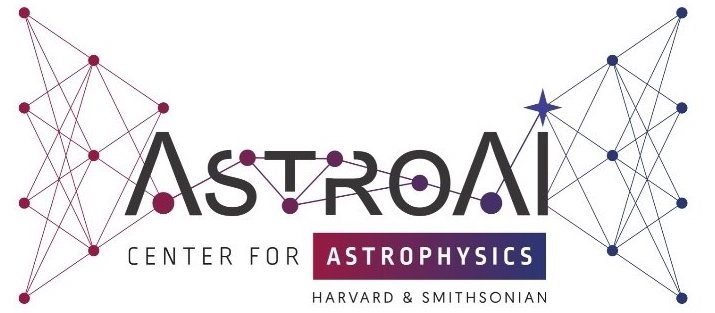AstroAI Workshop 2025
Contributed Talks:
- Luca Gomez Bachar: Evolution of linear matter perturbations with error-bounded bundle physics-informed neural networks
- Eddie Berman: Augmenting Spectra Emulation with Deep Evidential Regression for the Purposes of Biomarkers Retrieval
- Srinadh Reddy Bhavanam: Deep Learning for Compton Image Reconstruction in Gamma-Ray Astrophysics
- Ingrid Vanessa Daza Perilla: Neural Posterior Estimation for MYTorus Decoupled: Training on Observation-Driven Parameter Grids
- Paul Gregory: A Novel and Scalable Transformer-based Classifier to Automatically Process Millions of TESS Light Curves
- Jack Grossman: A Diffusion-Based Machine Learning Model to Infer the Neutrino Effects from Large Scale Structure
- Aryana Haghjoo: Super-Resolving Low-Resolution Galaxy Spectra with Diffusion Models
- Ilay Kamai: Key Stellar Parameter Predictions with Multi-Modal Neural Networks: Extending Deep Learning to Spectroscopy and Photometry
- Ashod Khederlarian: Deep Learning Photometric Redshifts for Roman
- Ole Koenig: Modeling X-ray photon pile-up with machine learning: A data-driven perspective
- Sayed Shafaat Mahmud: Inferring Planet and Disk Parameters from Protoplanetary Disk Images Using a Variational Autoencoder
- Pablo Mercader Perez: Reconstructing Starspot Maps from Transits Using Deep Learning
- Sebastian Ratzenboeck: Learning with Gaps: A Domain-Adaptive SBI Framework for Mapping Young Stars from Incomplete, Multi-Survey Data
- Markus Michael Rau: Leveraging Approximate Models for Exact Inference: A Hybrid AI-MCMC Approach
- Nandini Sahu: Gravitational Lensing and the Need for AI-Accelerated Lens Modeling
- Sogol Sanjaripour: Unsupervised Learning of Galaxy SED: AGN Identification and contamination correction
- Ann-Kathrin Schuetz: From LEGEND to Binary Black Hole: A Rare Event Journey Across Physics
- Dimitrios Tanoglidis: Multimodality and Multimodal Models in Astrophysics
- Yi Yang: AstroAgent: An Intelligent Assistant for Astronomical Research Based on MCP Protocol
- Martin Ying: Flowing Through Stellar Model Uncertainties: The Dartmouth Stellar Evolution Emulator
Posters:
- Lidiya Ahmed: Machine Learning for Faraday Cup Calibration and Optimization of Ion Parameter Estimation
- Srinadh Reddy Bhavanam: MargFormer: Photometric Classification of Stars, Quasars and Compact Galaxies with Cross-Attention Vision Transformer
- Antoine Bourdin: Diffusing Galaxies onto Dark Matter Fields over Multiple Cosmologies and Astrophysics
- Rocco Di Tella: Building Honest Agents Through Introspection: Probe-driven Generation of Confidence Scores
- Steven Dillmann: Representation Learning for X-ray Transients
- Rosa A Gonzalez: Using AI tools to determine the globular cluster system -- total galaxy stellar mass relation at z=0.4
- Hossein Hatamnia: AI-Driven Methods for Identifying Cosmic Web Environments
- Bradley Hutchinson: A Sequential Unsupervised Learning Approach for Large, Multicolor, Photometric Surveys
- BAIMAM BOUKAR JEAN JACQUES: Explainable Deep-Learning Based Potentially Hazardous Asteroids Classification Using Graph Neural Networks
- Naysha Jain: Exospore: AI-Driven Detection of Microbial Life for Planetary Protection
- Rintaro Kanaki: Evaluation and Modeling of Spatial Selection Effects in Photometric Redshifts
- Fulya Kiroglu: When Stars Collide: Letting Neural Networks Pick Up the Pieces
- Christina X. Liu: Analyzing the Impacts of Stellar and Planetary Parameters to Exoplanet Habitability through Machine Learning
- Kiera McCormick: Evaluating Large Language Models in Astronomy Research
- Carolyn M Mill: Investigating Survey Systematics with Bayesian Statistics
- Lorenzo Monti: CLiMBing the Galactic Ladder: Unveiling Hidden Structures with Semi-supervised Clustering Algorithms
- Drew Oldag: Hyrax
- Andrea Persici: Blended Source Detection in Deep Fields: A Max-Tree Approach Informed by Survey and Simulated Data
- Fiona Redmen: Expediting Black Hole X-Ray Spectroscopy: Variational Auto-Encoders with Normalizing Flows
- Ashwini Nagaraj Shenoy: Solar Flare Forecasting using Machine learning/Deep learning techniques
- Abu Bucker Siddik: Degeneracy-Aware Pulsar Parameter Estimation from Light Curves via Deep Learning and Test-Time Optimization
- Adiba Amira Siddiqa: Using Deep Neural Networks to Detect Dark Star Candidates in the Early Universe
- Jared Sofair: Spectrophotometric Inference of Stellar and Binary Parameters
- Nicolò Pinciroli Vago: Learning compact representations from Chandra X-ray spectra
- Akash Vani: Machine learning-based emulator for large-volume semi-analytical galaxy formation models
- Jennifer Yee: LensNet: Enhancing Real-time Microlensing Event Discovery with Recurrent Neural Networks in the Korea Microlensing Telescope Network
- Dmitrii Zagorulia: Morphological Classification of Jets in Active Galactic Nuclei
